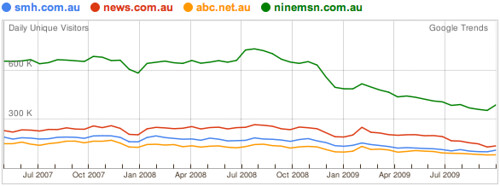Right about now, most marketers will be starting to set their budgets for next year. We are looking at what worked this year, what didn’t, and thinking about how we can capitalise on the positive momentum and new product/feature launches that are planned for 2010. For some this means buying media. For others it means looking at earned media.
One of the very first things I do is to look at where my customers are playing. And by “playing”, I mean, where do they spend their time. How do they break down their days? I am looking for an understanding of their BEHAVIOUR. I am looking for opportunities to ENGAGE, not chances to interrupt. I’m seeking participation.
For me, it starts with data. I feed this into my continuous digital strategy process (regardless of whether it is digital or not). I look at the Google Trends data and I cross pollinate it with my own web analytics information. What do I see? I see the phenomenon that Ian Lyons is seeing. On the Datalicious blog, Ian suggests that Australian Brand Sites are Losing to the Social Web:
- We are hanging out in social sites where relevant content finds us through our friends rather than searching out brands
- Content is being pushed off-site through mechanisms such as RSS Feeds, Twitter, YouTube Channels and Facebook Fan pages
Ian shares a number of graphs to to demonstrate (take a good look at the post for more), but this one above clearly shows a significant fall in the number of daily unique visitors to all Australian online media properties. The most dramatic fall belongs to NineMSN.com.au. The important thing to remember with this, is that consumers haven’t suddenly lost half of their time or attention – they are shifting attention (their precious resource) to other places. And clearly consumer behaviour is not shifting to brands or even brand websites – it’s shifting to our friends, connections and family – online.
Facebook is the big winner. It’s winning because the future of your brand is social. It is winning because the decisions we make are now social. And as consumer behaviour and action continues to shift, as people continue to rely on social judgement as a means of filtering the thousands of advertising and branded messages they encounter each day, brands are going to struggle to remain relevant or even interesting.
It’s time to think about what I call the Auchterlonie Effect. It’s time, as Ian suggests, for brands to think of themselves as (niche) publishers. And it’s time to think about shifting that media budget of yours away from SPENDING and into INVESTMENT. Remember, on the web, content lasts forever. Use that insight to your advantage!

